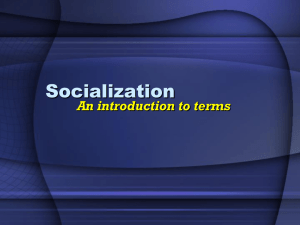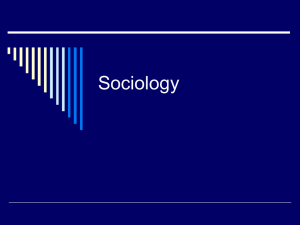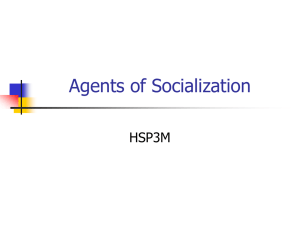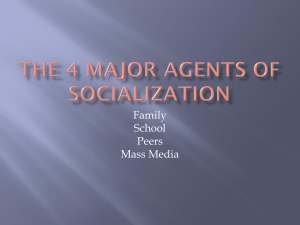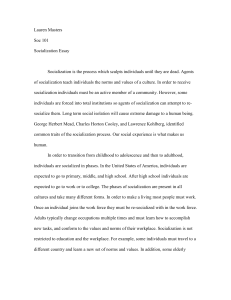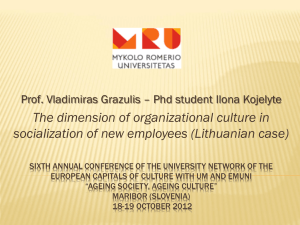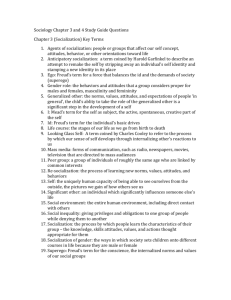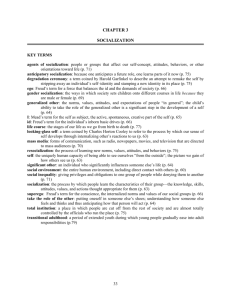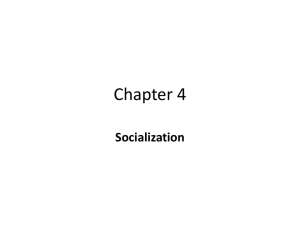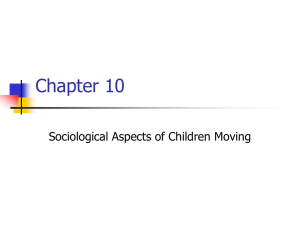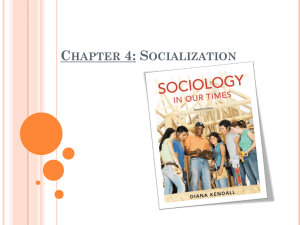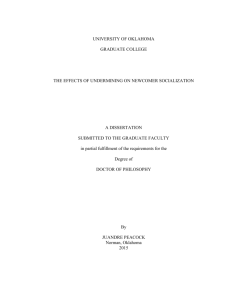role - Sakai
advertisement
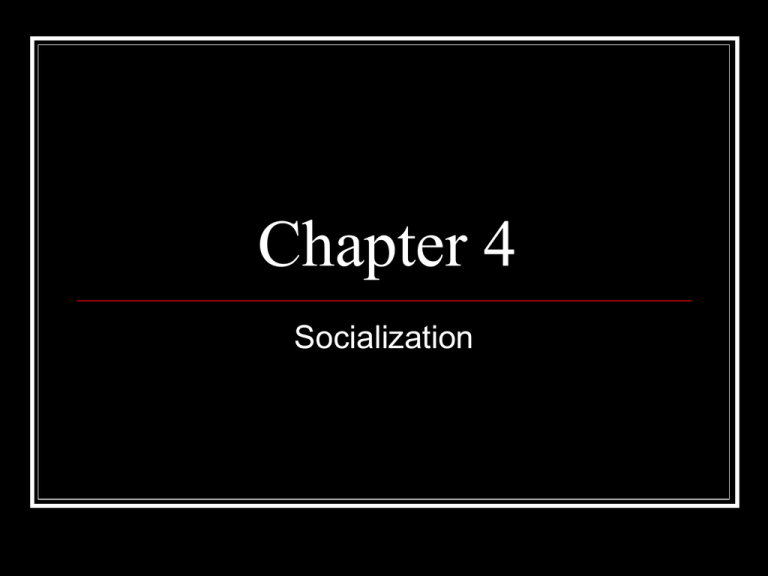
Chapter 4 Socialization Socialization A process by which people develop their human capacities and acquire a unique personality and identity and by which culture is passed from generation to generation. Internalization The process in which people take as their own and accept as binding the norms, values, beliefs, and language needed to participate in the larger community. Coming to Terms How do members of a new generation learn about and come to terms with the environment they have inherited? How is conflict between groups passed down from one generation to another? Nature and Nurture The process of socialization involves both. Nature is the human genetic makeup or biological inheritance. Nurture is the environment or the interaction experiences that make up every individual’s life. Social Contact Meaningful social contact with and stimulation from others are important at any age. Cases of extreme isolation prove that development is impeded. Individual and Collective Memory Engrams are chemically formed entities in the brain that store in physical form a person’s recollections of experiences. Collective memory is the experiences shared and recalled by significant numbers of people. Groups 1. 2. 3. Share a distinct identity. Feel a sense of belonging. Interact directly or indirectly with one another. Primary Groups A primary group is a social group characterized by face-to-face contact and strong emotional ties among its members. Families are key example. Other Agents of Socialization School Has a mandate to socialize children to societal norms Functionalists indicate schools fulfill function of socialization leading to social cohesion Conflict theorists suggest schools reinforce divisive aspects of social classes (e.g. Teachers praising boys may reinforce sexist attitudes) Polling Question Which agent of socialization do you think is the most responsible for gender differences in how males and females are socialized? 50% A. B. C. D. E. The Family Religion The Peer Group Education Mass Media 38% 13% 1 2 0% 0% 3 4 5 Other Agents of Socialization (cont) Media Example: Television Peer Groups Workplaces Religion Ingroups and Outgroups An ingroup is a group with which people identify and to which they feel closely attached, particularly when that attachment is founded on hatred from or opposition toward an outgroup. An outgroup is a group toward which members of an ingroup feel a sense of separateness, opposition, or even hatred. Suicide: Severing Group Relations Durkheim defined suicide as the severing of relationships. Durkheim identified four types of problematic social relationships: egoistic, altruistic, anomic, and fatalistic. Problematic Social Relationships Egoistic social relationships involve a state in which the ties attaching the individual to others in the society are weak. Altruistic social relationships involve a state in which individuals have no life their own and strive to blend in with the group to have a sense of being. Problematic Social Relationships Anomic social relationships involve a state brought on by dramatic changes in economic circumstances. Fatalistic social relationships involve a state in which there is no hope of change and thus an environment of oppressive discipline against which there is no chance of appeal or release. Self-Development The emergence of a sense of self depends on our physiological capacity for reflexive thinking. Reflexive thinking is the process of stepping outside the self and observing and evaluating it from another’s viewpoint. Significant Symbols Significant symbols and gestures are the mechanisms that allow an individual to interact with others and, in the process, to learn about the self. A significant symbol is a word, gesture, or other learned sign used to convey a meaning from one person to another. Symbolic Gestures Nonverbal cues, such as tone of voice and other body movements, that convey meaning from one person to another. Role Taking The process of stepping outside the self and imagining how others view its appearance and behavior imaginatively from an outsider’s perspective. Stages of Role Taking Children learn to take the role of others through three stages: preparatory, play, and games. Each of these stages involves a progressively more sophisticated level of role taking. The Preparatory Stage In this stage, children have not yet developed the mental capabilities that allow them to role-take. They may mimic or imitate people in their environment but have almost no understanding of the behaviors that they are imitating. The Play Stage Mead saw children’s play as the mechanism by which they practice role taking. Play is a voluntary and often spontaneous activity, with few or no formal rules, that is not subject to constraints of time. The Play Stage In the play stage, children’s role taking comes from what they see and hear going on around them. In the play stage, children pretend to be significant others —people or characters who are important in their lives, in that they have considerable influence on a child’s self-evaluation or encourage the child to behave in a particular manner. The Game Stage Games are structured, organized activities that usually involve more than one person and a number of established constraints concerning roles, rules, time, place, and outcome. Games teach children to follow established rules, take the roles of all participants, and see how their position fits in relation to all other positions. The Game Stage Through playing games, children learn to organize their behavior around the generalized other —that is, around a system of expected behaviors, meanings, and viewpoints that transcend those of the people participating. The Looking-Glass Self The looking-glass self is a process in which a sense of self develops such that people see themselves reflected in others’ imagined reactions to their appearance and behaviors. Cognitive Development Piaget believed that learning and reasoning form an important adaptive tool that helps people to meet and resolve environmental challenges. He developed the theory of active adaptation, which is a biologically based tendency to adjust to and resolve environmental challenges. Cognitive Developmental Stages Sensorimotor stage - birth to about age 2 Preoperational stage - about ages 2 to 7 Concrete operational stage - about ages 7 to 12 Formal operational stage - the onset of adolescence onward Resocialization The process of discarding values and behaviors unsuited to new circumstances and replacing them with new, more appropriate values and norms. Total Institutions Institutions in which people surrender control of their lives, voluntarily or involuntarily, to an administrative staff and carry out daily activities with others required to do the same thing. Social Interactions Everyday events in which at least two people communicate and respond through language and symbolic gestures to affect one another’s behavior and thinking. Context and Content When sociologists study social interaction, they seek to understand and explain the forces of context and content. Context The larger historical circumstances and social forces that bring people together for social interaction. Content The cultural frameworks (norms, values, beliefs, material culture) that guide social interactions, specifically behavior dialogue, and interpretations of events. Social Status Social status A position in a social structure. Social structure Two or more people occupying social statuses and enacting roles. Social Roles A role is the behavior expected of a status in relationship to another status. People occupy statuses but they enact roles. A role set is an array of roles. Rights and Obligations Role expectations include both rights and obligations. Rights are the behaviors that a person assuming a role can demand or expect from others. Obligations are the relationship and behavior that the person enacting a role must assume toward others in a particular status. Role Strain and Conflict Role strain is a predicament in which contradictory or conflicting expectations are associated with a single role that a person is enacting. Role conflict is a predicament in which the expectations associated with two or more roles in a role set contradict one another. The Dramaturgical Model A model in which social interaction is viewed as though it were theater, people as though they were actors, and roles as though they were performances presented before an audience in a particular setting. Impression Management The process by which people in social situations manage the setting and their dress, words, and gestures to correspond to the impressions they are trying to make or the image they are trying to project. Staging Behavior The division between front stage and back stage is found in nearly every social setting. Front Stage The region where people take care to create an maintain the images and behavior an audience has come to expect. Back Stage The region out of an audience’s sight where individuals can do things that would be inappropriate or unexpected on the front stage. Quick Quiz The last of Piaget’s cognitive developmental stages is: 25% 25% 25% 25% a) b) c) d) Sensorimotor Preoperational Concrete operational Formal operational a b c d Answer: d The formal operational stage is the last of the cognitive developmental stages that Piaget defined. If you are viewing social interactions as though they were theater, you are practicing: 25% 25% 25% 25% a) b) c) d) Attribution Theory Dramaturgical Model Solidarity Role Strain a b c d Answer: b If you are viewing social interactions as though they were theater, you are practicing the Dramaturgical Model. Role expectations are socially prescribed and include both: 25% 25% 25% 25% a) b) c) d) front and back stage behavior conflict and strain rights and obligations context and content a b c d Answer: c Role expectations are socially prescribed and include both rights and obligations. The process of discarding values and behaviors and replacing them with more appropriate values and norms is: 25% 25% 25% 25% a) b) c) d) socialization self-development role-taking resocialization a b c d Answer: d Resocialization is the process of discarding values and behaviors and replacing them with more appropriate values and norms. Which stage of role-taking teaches children to follow rules? 25% 25% 25% 25% a) b) c) d) preparatory play games preoperational a b c d Answer: c The games stage of role-taking teaches children to follow rules.
